Sounds, sound poetry, and sound/text compositions
Jas. H. Duke
This article first appeared in
NMA10
magazine. In it, the author takes a fresh look at
sound poetry in the Twentieth Century, and offers
some practical advice to the Sound Poet/Sound
Text Compositionist of today. Included is a
previously-unpublished performance poem.
Sounds
There exists an artform that (like an elephant) is instantly recognisable but (again like an elephant) is difficult to define. This is where a human voice, a remarkably versatile device, is modulated to produce loud sounds, soft sounds, high sounds, low sounds, fast sounds, slow sounds and all sorts of sounds in between. Ever since the dawn of time people have made sounds come from their mouth and nose. Some of these sounds get put in the box marked `speech' while other get put in the box marked music. Some don't seem to be either and can't find an appropriately labelled box. But when looked at closely our `speech' and `music' boxes can be seen to have elastic sides and to have a lust to couple with each other.
Sound Poetry and the Churches Era
`Sound Poetry' as normally defined makes a first appearance in the early 20th century as an outrider of the great army of Modernism. (Of course there were sounds long before that but they needed clothes that convinced listeners that they were really something else). The pernicious nature of the times meant that the Modernists organised themselves rather like secret societies, or political parties, or schismatic christian churches. That is they were small groups of true believers, generally led by some sort of Messiah figure (eg Marinetti, Gumilev, Andr , Breton, Herawath Walden) who constructed a canon of acceptable works, welcomed in right-minded colleagues and collaborators, produced bibles and prayer books for new recruits, denounced false prophets, and excommunicated spies and traitors. In this way Futurists (both `Italian' and `Russian' brands), Expressionists (`Germans' and `others'), Dadaists, Surrealists and their innumerable splinter groups rampaged across culture, throwing up a few sounds of interest in amongst their denunciations of the bourgeoisie and each other. The spirit of the times ensured no co-operation between the various churches. The various messiahs spent as much time claiming that they were "the first" and denouncing the false messiahs of the church next door as actually producing sounds. For instance the Dadaist movement had a very short life as a movement but then Dadaists found a much more satisfying occupation - lasting 40 years or more - in arguing with each other about who had thought up the name "Dada". This religious dissension means that Futurists ignore Surrealists, Expressionists ignore Dadaists, and so on through all the possible permutations and combinations. Historians of Modernism generally have trouble with anything outside narrow fields of reference and find no difficulty in discussing Schwitters while ignoring Stramm, analysing Arp while ignoring Marinetti, and mentioning Heynicke while ignoring Hausmann. Although sound poetry should be able to leap the boundaries of national languages anthologists insist on inserting French sound poets into French language anthologies, Germans into German books, and Americans into books dealing with America.
Sounds and Obsessions
Various obsessions governed the work of leading sound poets of the Churches era. Marinetti (Futurist of Italy) and Heynicke (Expressionist of Germany) became obsessed with war and strove to write works which would reproduce the sounds and emotions of battles. With Marinetti, this took the form of sheets of sound intended to represent artillery shells bursting, machine guns and rifles firing, land mines exploding, cries of the wounded and dying, and the triumphant shouts of the victors. Something like this resulted:
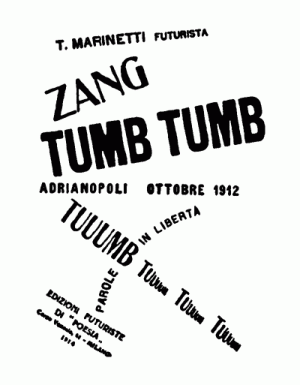 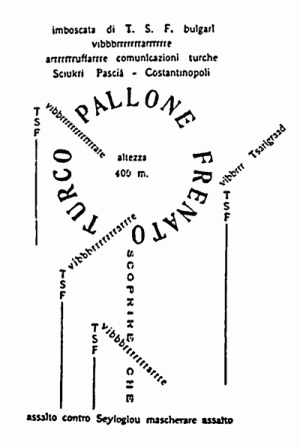 |
Heynicke, although equally a war lover, in contrast went for a single note system and produced works like `Blood / Mud / Death / Brown Flood Again / Back / Past...' etc ( Attack ). Expressionist sound poetry is characterised by this `telegraph' style, first used by Stramm and refined by Heynicke. Dadaists liked to think of themselves as `Wild Men' who had broken all forms of restraint and whose work required a certain amount of randomness, unexpectedness, and chance decisions. However they mostly lacked any real talent for improvisation and fell back on memorised scripts, for example Hugo Ball's Karawane :
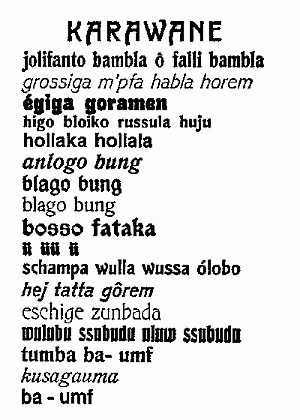 |
Hausmann, a little later in time made a virtue of this and claimed that the typographic style of his `Phonemes' allowed the reader to instantly recognise what sound was intended.
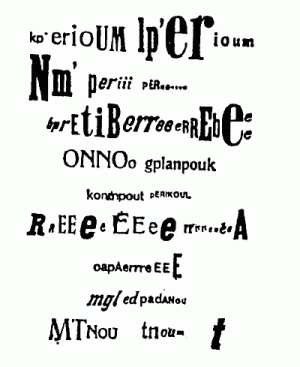 |
Mayakovsky (the Futurist of Russia) wrote `conventional' rhyming poetry but he was a much more practised, competent, and able reader of his work in public than small scale people like the Dadaists for all their technical innovations. Mayakovsky was called on to perform to much larger audiences (often indifferent to `art' and potentially hostile), and to perform more often. He developed a method of laying out his work on the page to assist the performer which looked like this:
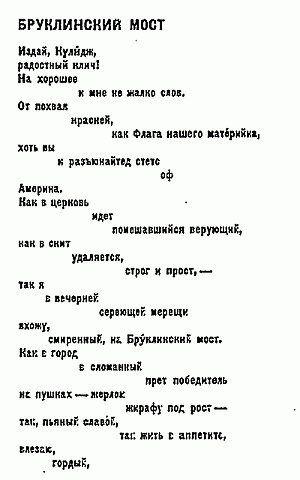 |
The German Kurt Schwitters who existed on the Dadaist fringes (the Dadaist synod denounced him as `bourgeois') developed a similar method.
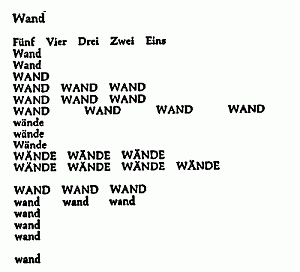 |
He was also a practised and confident performer, much more interested in performance than in the theory of performance. He was also a painter, a collagist, a constructor of mysterious towers made of everyday objects, an advertising artist, a writer of cryptic little playlets, a lover of puns, and a wearer of doublebreasted chalkstriped suits. Critics on the whole dislike all rounders and prefer Johnny One Notes of Taste and Refinement.
Others
Of course there were other sound poets of ability around during these times and some of them managed to appeal to wide audiences by the trick of not labelling their sound poetry as `Art'. For instance Rudyard Kipling managed to write a sound poem ( Boots-Boots- Boots-Boots- Movin' Over Africa, Boots-Boots- Boots- Boots - Moving' Up and Down Again ) which millions of people who regarded modern artists rather like a dangerous species of rattlesnake managed to bellow out with love and devotion while intellectuals cowered back in horror at the vulgarity of it all.
The Churches in Ruins
The period of the Modernist Churches died away and, although some of the sound exponents lived for many years afterwards, the decision makers of `Art' were soon able to brand their work as `old hat', `passe' etc, and completely ignore it. This strand of sound poetry soon became only of interest to fussy antiquarians obsessed with splitting ancient hairs. Mayakovsky shot himself dead and his ghost was embraced by Stalin (`he was and is the greatest poet of our Socialist Epoch and indifference to his memory is a crime') which has ensured that his work counts for zilch.
Hitler, the People, and the Tom A. Edison Grab-Bag of Delights
Meanwhile back in the real world non-artists and non-modernists were also producing sounds. Microphones, phonographs, radios, amplified public address systems, motion pictures, advertising jingles and the whole Tom A Edison grab-bag of delights enabled singers and songwriters to forget about Beautiful Dreamer , My Grandfather's Clock , The Harp That Once in Tara's Halls , and similar horrors of the previous generation and write things like Maisie Doats And Dosie Doats And Little Lambs Eat Ivy , I Tawt I Taw A Putty Tat and He Thwam And He Thwam All Over The Dam which exposed `the People' to something other than rigid forms of convention. Jazzmen, used to blowing down trumpets and saxophones, discovered they could make interesting sounds without the trumpet or the saxophone (listen to Clark Terry's Mumbles or Dizzy Gillespie's Salt Peanuts ). Demagogic politicians like Hitler, found suitably amplified sound poetry highly necessary. Examination of Hitler's speeches will show that many of them consist almost entirely of loaded and coded phrases like Das Ganze Volk , Deutschland and Juden Raus endlessly repeated in the Schwitters manner. After these performances nobody should doubt the ability of sound poetry to inspire millions of listeners. In addition Hitler had powers denied to the various messiahs of Modernism as he could imprison, torture and kill rival artists with impunity and without reprisals. Hitler could also involve the whole German people in his sound poetry by eschewing the passive acquiesence required by previous and subsequent dictators and have his subjects shout Heil Hitler every time they opened their mouths.
A New Breed Makes its Presence Felt
After this convulsion had resolved itself little was left of sound poetry or sound poets. In its place rose another breed of human voice sound, this one deriving from `new music' (of the North American brand rather than the European) instead of from Modernist language. Its exponents were usually American, had attended some cultural educational establishment, were usually quiet and well-behaved (no wild men this time), were quite well-informed about culture and its place in society, and had a proper respect for good design, wall street, coca cola, the civilising mission of the USA, the hopelessness of socialism, the benefits of business driven technology, and the burning question `What happened to our simple country virtues?'
The USA and a Paradigm Shift
The USA, being a society of traditions and backward glances over travelled roads, is currently hurtling back into a hi-tech version of the 13th Century. The nobility and gentry are fortifying themselves in castles guarded by paid bodyguards. The universities are in a similar role to that played by medieval monasteries. Sports and television (now closely linked) have taken over from religious festivals. Every now and then crusaders are sent to foreign parts to smite infidels. The phrase Only in America is often invoked. Art must conform to this paradigm shift, it must either make itself indispensable to the nobility and gentry or get involved in the religious festival business. There thus has to be a certain amount of giving the customer what the customer thinks the customer wants. This differs from the Churches Era where the various messiahs decided that what the customer thought the customer wanted was totally unimportant, what mattered was what the Messiah wanted.
Johnny One Notes of Taste and Refinement
Instead of their speech being the denunciation of the bourgeoisie and rival artists this new breed instead spoke a language of technological fashion, vaguely reminiscent of the fashion pages of Vogue, where the slightest mis-phrasing inexorably identified the washed-up, pass , , has-been. True citizens of a land where the poor won't work because they're paid too much while the rich won't work because they're not paid enough. This new breed were not poets so their work was not sound poetry. Instead they produced `sound/text compositions'. They did not read in the strident vehement manner associated with Marinetti (or Hitler) but in a low key buttoned-down sort of voice, suitable for the titillation of cultured moneybags in search of something new. The Age of Cold Wars and Thermonuclear Devices cultivated restrained works like Charles Amirkhanian's The Drano Ducks Collide . A certain gentle satire (often at the expense of the cultured moneybags) is present. To tell the truth denunciations of the bourgeoisie could have remained in fashion, no cultured moneybags wants to be mistaken for a bourgeois. Presentation, a minor concern in the Age of Churches, became important. Critics still preferred Johnny One Notes of Taste and Refinement. In a way this fawning and truckling to cultured moneybags is a throwback to the days of W.A. Mozart when musicians occupied a similar position to grooms, valets and chambermaids.
Real World Developments
Real world sounds still continued to appear although trumpets and saxophones ceased to be people's weapons, they became `Art', they were replaced by electric guitars, disembodied keyboards and samplers as the people's sound devices. This enabled people's musicians to warble lugubrious and lachrymose songs of love along with amplified chords stolen from ancient bluesmen and gospel singers from lost cotton plantations. Advertising (or giving the customer what they really want) continued to be a major artistic influence. It was also the age of hi-fi and stereo, of wide screens in theatres and small screens in living rooms, T-shirts, hair, recreational drugs, and a certain amount of aggressive and fumbling sex. Morality was determined by accountants and tax lawyers. Image often overpowers sound in people's culture, tailoring triumphs and costume aptness is equated with moral worth. But there was still room for Be-Bop-A-Luba-Bip-Bam-Bop , Spark-A-Lark-A-Lark-A-Ling , Safe As Milk , Drove My Chevvy to the Levee but the Levee was Dry , and 1-2-3 What Are We Fighting For?
The Spirit of Nostalgia and Revivalism
Revivalism and the Spirit of Nostalgia also revived some interesting work in the style of the Churches Era such as The Four Horsemen from Canada - listen to their Assassin or Mayakovsky . Like most revivalists they are better than the original. Unlike the Churches Era there is more work for women (eg Meredith Monk). Women of the Churches Era were to be seen and not heard.
A Modern Virtuoso
The 1980s did produce a genuine virtuoso, a Paganinni of the Voice, a performer with more talent than Schwitters or Marinetti or Mayakovsky. This is Bobby McFerrin. Like most virtuosi he is as capable of embarrassing and infuriating admirers and potential admirers in that his taste and his abilities often seem on a collision course - he is always liable to halt and give all the credit to Jesus, or break into Don't Worry Be Happy . But he has really got it with a capital `I' and his record The Voice is sound poetry as it should be sounded [1] . Listen particularly to I'm My Own Walkman . Let's hope that his hit records give him a good living, without the fawning and truckling to cultured moneybags that artists have to go through in order to survive.
What is to be Done?
Sound Poetry and Sound Text Compositions have never occupied centre stage while they have remained under those labels. Sound Poets (or S/T Compositionists) who got into the spotlight, like Kipling and Hitler, acquired millions of admirers while dressing up sound poetry as The Essential Rightness of British Imperialism or The Historic Mission of the German People to Bash the Jews. Let there be no mistake over their popularity, at one time Boots was being declaimed on every music hall stage in the British Empire while at another time the raucous (but powerful) sounds of Hitler shrieked from every German radio set. The sound poetry was noisy and flashy, like the organised violence that these authors saw as the answer to all problems. Audiences stood ready to cheer every statement, no matter what it was, to them Imperialism was good in all its forms, Jew-bashing was good in all its forms. While Hitler was regarded as a mighty elemental force (`mad genius' or `vulgar little man' are as far as critics want to go in criticism then and now) his gentle comtemporary Schwitters was (and is) universally regarded as a weirdo.
So the Sound Poet/Sound Text Compositionist of today who seeks `fame,
recognition and non-wimpishness' needs to tap into some currently popular
cause. And what is popular today with decision-making important people?
Obviously economics of the modified Adam Smith brand (with A.S's `enlightened
self-interest' being replaced with just plain self-interest). The
sound/text composition
The Economist's Song
is suggested as a sure-fire winner of popularity.
Footnote
1. Bobby McFerrin's record is
The Voice
Elektra Musician 960 366-1 and was recorded at live performances in Germany in
March 1984.
back